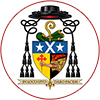“Mary gave birth to her first born, and she wrapped him in swaddling clothes and placed him in a manger, because there was no room for them in the inn.” In our Christmas crib scene, Jesus lies in a manger as a sign of poverty and exclusion. Tradition surrounds Jesus with beasts: the ox and the ass, the lambs carried in by the shepherds, and later the camels of the Magi. These are the fruit of faith-filled devotion and imagination, but this traditional setting is faithful to what Luke briefly narrates: that the one born to be King is removed from human habitation. ‘There was no room in the inn’. He is placed outside, where the beasts live.
There is a story in the Old Testament, in the Book of Daniel, about a great king, Nebuchadnezzar. In this story the King must dwell with the beasts of the field. He is removed from the normal human condition, from his right mind, until he knows ‘that the Most High rules the kingdom of men, and gives it to whom he will’ (Dan 4:25). The King, to become truly King, to rule as he should rule, must experience the extreme consequences of humanity’s estrangement from God: not knowing God, he no longer knows himself, he is ‘out of his mind’. He is with the beasts. Paradoxically, by being with the beasts, he recovers true humanity, and is restored to his right mind.
The prophet Isaiah says: “The ox knows its owner, and the ass its master's crib; but Israel does not know, my people does not understand” (Isa. 1:3). Like King Nebuchadnezzar, God’s people is out of its right mind, because it doesn’t understand God. The dumb beasts, the ox and the ass, show the way to sanity, because dumb though they are they know their owner and master.
Looking at Jesus in the crib, we recognize our own humanity. He bears in his flesh from his birth our estrangement from God and from one another. He is with the beasts. And in the crib, with the ox and the ass that know their master, we discover our way to understanding, to knowledge of God and the recovery of our humanity.
Later in the same book of Daniel that gave us Nebuchadnezzar with the beasts of the field, there are other beasts, savage ones, not the tame beasts of the field, but beasts from the sea:
“I saw in my vision by night, and behold, the four winds of heaven were stirring up the great sea. And four great beasts came up out of the sea.” These are not any beasts known to nature. They do dreadful things. They are symbolic of the human empires that arise one after the other on earth and persecute God’s people, powers that seem human, but are bestial in their ferocity.
The description of these four beasts is strangely reminiscent of the four living creatures in Ezekiel’s vision of the glory of God. Ezekiel’s four creatures are all the same, Daniel’s are different from one another. Ezekiel’s creatures all have aspects of a man and of animals, a lion, an eagle and an ox. In Daniel, the first is like a man, a lion and an eagle (but not like the placid ox), but the next beasts are like more savage creatures, a bear and a leopard, with no humanity, and the fourth is indescribable. Ezekiel’s creatures all move in perfect harmony in the same direction. Daniel’s beasts create havoc all around them.
Ezekiel’s creatures are part of a heavenly vision of the glory of God. In the vision, one lifts up one’s eyes and over the four creatures is ‘the appearance of the likeness of the glory of the Lord’ (Ezek. 1:28). Daniel’s four creatures are a vision of something else, a power unleashed on mankind that has at first a human appearance but is not human. Yet Daniel’s vision too brings us to see the glory of the Lord. The power of the beasts is taken away, and ‘with the clouds of heaven there came one like a son of man, and he came to the Ancient of Days and was presented before him. And to him was given dominion and glory and kingdom’ (Dan 7:13-14).
All this might seem far from the ox and the ass and the lambs and the camels at the crib. But the Gospel invites us to see in the child lying in the manger among the beasts the ‘Son of Man who has nowhere to lay his head’, more homeless even than beasts, because ‘foxes have holes and the birds of the air have nests’. In his exclusion from the inn there is a foreshadowing of his being taken outside the city, where all that is bestial in humanity and the powers of hell will surround him and do battle with him. The battle will end with his victory and his enthronement, on the Cross.
All of this is contained in the crib. We know all this. Still we are drawn to the crib. We are drawn by a vision of peace, and we rightly take this vision away with us. The child sleeping with the beasts is an image of the peace that the Messiah brings, as Isaiah prophesied:
‘The wolf shall dwell with the lamb, and the leopard shall lie down with the kid, and the calf and the lion and the fatling together, and a little child shall lead them. … They shall not hurt or destroy in all my holy mountain; for the earth shall be full of the knowledge of the Lord, as the waters cover the sea’ (Isa. 11:5-9).
